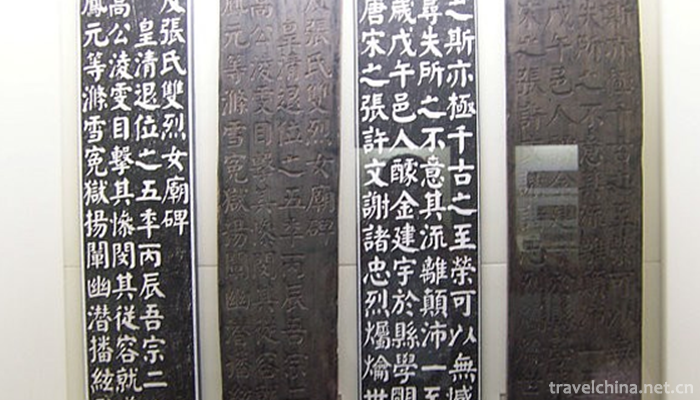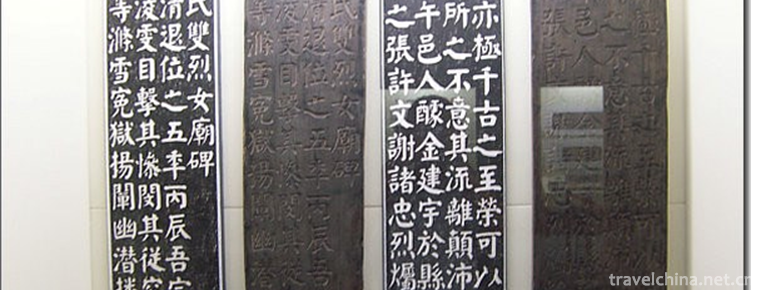Rubbing and Printing Skills of Hengshui Inscriptions
Rubbing and Printing Skills of Hengshui Inscriptions
Hengshui Law Tie Engraving and Printing Technology, the traditional handicraft of Taocheng District, Hengshui City, Hebei Province, is one of the national intangible cultural heritage.
The history of Hengshui wooden carving can be traced back to Tang Dynasty. It flourished in Ming Dynasty and Qing Dynasty. Its exquisite carving skills fully show the exquisite Chinese character calligraphy.
On May 23, 2011, Hengshui Law's engraving and rubbing technology was approved by the State Council and listed in the third batch of national intangible cultural heritage list, item number_-201.
historical origin
The history of the rubbing of Yanzhuang calligraphy can be traced back to the Tang Dynasty. In the eighteenth year of Tang Zhenguan (644), when the sick Taifu Gavenda of Shu Dynasty died in Chang'an, he was buried in the ancestral Tomb of Dongge Village in Taocheng District of Hengshui. The inscription was written by the great calligrapher of Tang Dynasty, Zhu Suiliang Shudan. Businessmen sell rubbings on-site, and rubbings are widely circulated. Later, people in the nearby counties of Hengshui County followed the example of businessmen selling rubbings. For a time, rubbings, papermaking and ink making rose among the villagers around Dongge Village. After thousands of years, to the nineteenth year of Emperor Kangxi of Qing Dynasty, "Hengshui County Chronicle" has a record of "today's peeling off" of the Gavenda tablet.
During the Northern Song Dynasty, the government prevailed to print the calligraphy of predecessors into ink collection. When the wise Hengshui people saw the inconvenience of engraving on the stone tablets, they copied the calligraphic ink of the famous masters of the past dynasties on the wooden board and then printed and mounted them, and sold them in volumes. Because the board is easy to handle and the engraving is time-saving and labor-saving, it has a great role in promoting the industrialization of the later rubbing technology.
In the late Ming Dynasty, Yan Rongzhang, a man named Yan Rongzhang, was an apprentice at the Tie Paver of Liulichang in Beijing. After returning to the village, he handed down the technique of carving Tie to the villagers of Yan Jiazhuang. Villagers handed it down from generation to generation. Everyone took carving as his skill and making Tie as his career. By the middle of Qing Dynasty, Yan Jiazhuang's carving of Fa Tie had formed an industrial chain. At the end of the Qing Dynasty and the beginning of the Republic of China, Yanjiazhuang Fa Tie entered the capital. According to the book "Xiao Zhi of Liulichang" compiled by Sun Dianqi, a Jizhou native, there are shops in the cultural street of Liulichang in Hengshui, where Yan Shizhu and Yan Bingyi master and apprentice operate Fa Tie and print calligraphy album pages. They are "Yimotang" opened in Guangxu 20 years and "Yunzhu Dun" opened in the 16th year of the Republic of China. During this period, because of the idea of reform, advocating new learning, setting up schools in the society, advocating equality between men and women, children were enrolled in school to study and learn Chinese characters. For a time, there was a great demand for copies of traditional calligraphy. This also promoted Yan Jiazhuang's calligraphy to expand the scale of production and operation. At that time, besides selling in Beijing, Tianjin and Hebei, Hengshui cultural traders also traveled to Shanxi, Shaanxi and China. Mongolia, Liaoning and other places for export.
By the outbreak of the War of Resistance Against Japan, Hengshui Tie had ceased because of the war, the founding of New China, the rise of new technology, the lack of access to traditional skills, the local legacy of Tie rubbings, rubbings and other precious cultural relics were destroyed as the "Four Old" in the "Cultural Revolution", surviving hundreds of old Tie boards has been a very small part. Since the 1990s, with the state's emphasis on the protection of cultural relics, Hengshui Tie Printing Technology has been listed in the national intangible cultural heritage protection list. The government has made great efforts to inherit this traditional technology by appointing inheritors, building museums and supporting the development of cultural industries.
Inheritance significance
Inheritance value
Hengshui Tie Printing Technology is not only an ancient printing technology that once promoted the spread of Chinese calligraphy art, but also an art that can be replaced by modern printing as a printing technology. However, as an art, it incorporates the producer's understanding and emotion of the original calligraphy art, and is converted into paper art form through woodcut and rubbing. This kind of production experience is essentially a kind of artistic creation, which has artistic value.
Inheritance status
There are fewer and fewer people who study Hengshui law stamp engraving and printing technology, which makes Hengshui law stamp engraving and printing technology face the problem of inheritance.
Inheriting characters
Yan Changhao, male, Han nationality, born in 1934 in Taocheng District, Hengshui City, Hebei Province. In 2008, he was selected as the representative successors of the first batch of intangible cultural heritage projects in Hebei Province.
Li Guangmin, male, Han nationality, born in 1972 in Taocheng District, Hengshui City, Hebei Province. In 2013, he was selected as the representative successors of the third batch of intangible cultural heritage projects in Hebei Province.
protective measures
In 1994, the State Administration of Cultural Relics allocated special funds to build the "Museum of Law Ties" in Baoyun Monastery.
In 2009, the Taocheng District Committee and the District Government of Hengshui City invested 700,000 yuan to move the Fate Museum into the People's Road Study Exhibition Hall in the city center.
social influence
In March 2009, Hengshui Law's engraving and rubbing technology became the only provincial intangible cultural heritage project in Hebei Province to participate in China's Intangible Cultural Heritage Exhibition Conference in Beijing.
In January 2011, the first cross-regional exchanges were achieved between block printing and French print rubbing, with "World Heritage" and "National Heritage" joining hands.


-
1.Chinese Shared bicycle
Shared bicycle refers to the bicycle sharing service provided by enterprises in campus, subway station, bus station, residential area,
Time 2018-11-13 -
2.Jiulian mountain
Jiulianshan Scenic Spot is located in Songshuping Village, Shangbali Town, Huixian City, Xinxiang City, Henan Province. It belongs to the south foot of Taihang Mountain
Time 2018-12-22 -
3.Xingwen sea
Xingwenshihai is located in Xingwen County, Yibin City, Sichuan Province. It is located in the transition zone between Sichuan Basin and Yunnan-Guizhou Plateau. Its total area is about 156 square kilo
Time 2018-12-24 -
4.Gudong Waterfall
Gudong Forest Waterfall Group Tourist Area is located at the foot of Butterfly Mountain - Lawn Road, Gudong Village, Dayuan Town, 8 kilometers away from Guilin City, on the other side of Lijiang Forei
Time 2019-01-12 -
5.Yellow River Grand Canyon
The Yellow River Grand Canyon is located in Qingtongxia Town, Wuzhong City, Ningxia. It is 20 kilometers away from Wuzhong City. It is a scenic spot of the Yellow River Canyon composed
Time 2019-01-18 -
6.Qingming Bridge Ancient Canal Scenic Area
Qingming Bridge Ancient Canal Scenic Area is located at the southern end of Wuxi city center, covering about 44 hectares of scenic area. The scenic spot is composed
Time 2019-02-07 -
7.Grass grass drums and drums
Grass gongs and drums, also known as grass chants, are commonly known as "hilarious songs". It is a unique form of folk song art. It is a kind of Tujia folk song that the
Time 2019-05-02 -
8.Liaoning wind and percussion ensemble
Liaoning drum music, commonly known as drum music. It is one of the traditional folk instrumental music in China. Liaoning drum music is divided into Suona music and Sheng wind music, and according to
Time 2019-05-13 -
9.Running curtain
Running curtain originated in the Spring and Autumn Period and Warring States Period, formed in the Qin and Han Dynasties, flourished in the Song, Yuan, Ming, Qing Dynasty and the early Republic of Ch
Time 2019-06-09 -
10.Anhui University
( Anhui University For short, "anda" is located in the provincial capital. Market It's the state. "Double First-Class" initiative "World class discipline construction," M
Time 2019-10-04 -
11.Wenchuan earthquake epicenter site
The earthquake site, located in Yingxiu Town, Wenchuan, Sichuan Province, is open all day.
Time 2020-11-07 -
12.Hydrological survey of Mianyang
Affected by the landform, Mianyang has abundant precipitation, large runoff, vertical and horizontal rivers and developed water system. There are more than 3000 rivers and gullies in the city. All rivers and gullies flow into Fujiang, Bailongjiang and Xihe
Time 2020-12-14